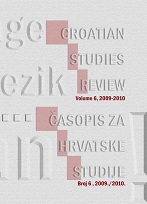Vladimir Nazor kao dalmatinski pisac
Vladimir Nazor, a Dalmatian poet
Author(s): Svein MønneslandSubject(s): Literary Texts
Published by: Croatian Studies Centre
Keywords: Vladimir Nazor; Brač; Croatian language; Chakavian dialect; Shtokavian dialect
Summary/Abstract: The article investigates Vladimir Nazor as a Dalmatian writer, focusing on his narratives from the so-called Brač Cycle (Brački ciklus). The stories thematize the island of Brač. The cycle comprises 37 stories published in three volumes and was written over a 25-year span. The first volume, entitled Childhood Stories (Priče iz djetinstva), was published in 1924. Interestingly enough, Nazor much later returned to these topics – the last collection of stories, on childhood memories, was written when he was 73. The Brač Cycle falls into two parts: the first comprises autobiographical lyric prose, prose-like poetry and poetic realism (Mihanović, 1999: 41); the second part was written after WWII, where Nazor’s return to childhood themes is only seemingly not connected with the social ones. The Brač cycle is a memoir. Nazor gives a realistic and versatile account of life on Dalmatian islands at the end of the 19th century. Therefore, he is a true Dalmatian writer. His prose is both realistic and poetic; it is mainly preoccupied with the goodness in people and with the island scenery. It is a testimony of island life as it once was. Nazor is a Dalmatian writer not only because of his stories’ content, but also because of the language he uses to create the local atmosphere. However, this usage is limited: there are few idiomatic expressions in the abovementioned texts, including the dialogues. The greatest number of localisms are found in the story “Water” (“Voda”). The characters mostly use the standard Croatian language with sporadic occurrences of idiomatic expressions which then contribute to the local touch of the narratives. The Shtokavian dialect, in this way, brings forth the Chakavian soul. Nazor was of the opinion that Chakavian is more than a mere sum of its words; rather, it relates to the qualities of word content, to the nucleus alive, to the Chakavian soul. Still, he did not use it much in his writing. He was often scorned for this, as for the fact that he never entirely mastered the Shtokavian dialect, as he was well aware. Nazor’s Dalmatian stories, which are a testimony of the Mediterranean past which existed not so long ago, should be made accessible to a wider foreign public through translation.
Journal: Croatian Studies Review - Časopis hrvatskih studija
- Issue Year: 2011
- Issue No: 7
- Page Range: 131-140
- Page Count: 10
- Language: Croatian

